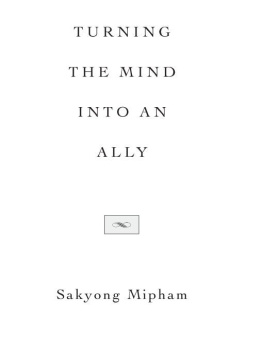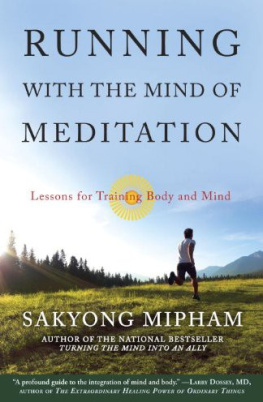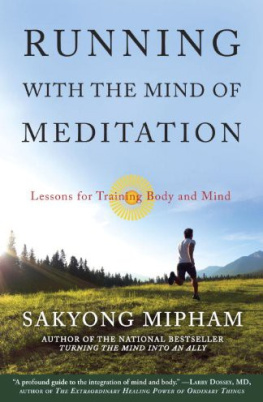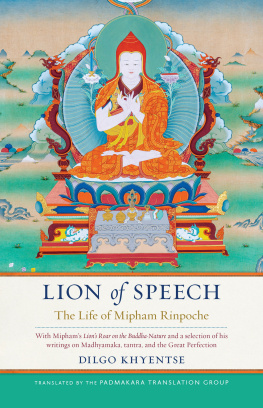Table of Contents
RIVERHEAD BOOKS a member of Penguin Putnam Inc. 2003
While the author has made every effort to provide accurate telephone numbers and Internet addresses at the time of publication, neither the publisher nor the author assumes any responsibility for errors, or for changes that occur after publication.
RIVERHEAD BOOKS
a member of
Penguin Putnam Inc.
375 Hudson Street
New York, NY 10014
Traditional verses on p. 213 translated by the Nland Translation Committee. Used by permission.
Copyright 2003 by Mipham J. Mukpo
All rights reserved. This book, or parts thereof, may not be reproduced in any form without permission. Published simultaneously in Canada
Library of Congress Cataloging-in-Publication Data Sakyong Mipham Rinpoche, date. Turning the mind into an ally / Sakyong Mipham. p. cm.
eISBN : 978-1-101-04325-7
1. MeditationBuddhism. 2. Spiritual life
Buddhism. I. Title
BQ5612 .S
294.34435dc21
This book is printed on acid-free paper.
http://us.penguingroup.com
To my father and mother,
CHGYAM TRUNGPA RINPOCHE
and
LADY KUNCHOK PALDEN
ACKNOWLEDGMENTS
I am grateful to the Vidyadhara Chgyam Trungpa Rinpochemy father, my teacher, and my best friend; His Holiness Dilgo Khyentse Rinpoche for guiding and inspiring me through challenging times; His Holiness Penor Rinpoche for his total support and blessings; Khenpo Namdrol for his teaching and wisdom; and Lama Pegyal, Loppn Rechung, and Loppn Gawang for their support and enthusiasm. Thanks to David Schneider for his original encouragement; Samuel Bercholz and Jonathan Green for their advice; Joe Spieler for helping me in the process; Amy Hertz for her vision, energy, and patience; and Pema Chdrn for her foreword. For their friendship and support, thanks to Lucas Dayley, Molly McCue, Judith Outlaw, and Rose Taylor. I also extend appreciation to all the people who have transcribed and edited my talks over the years.
For their generosity and daring, I thank Mark Butler, Wells Christie, Jeff Cohn and Jane Carpenter Cohn, Neal Greenberg, James and Sharon Hoagland, and in particular, Amy Bajakian, who offered me her home to work in whenever I wanted to. I appreciate the personal support of Douglas Anderson, Barry Boyce, David Brown, Dinah Brown, David Cook, Susan Dreier, David Ellerton, Jesse Grimes, Richard Hart-man, Kevin Hoagland, Noel McLellan, Joe Mauricio, John Sennhauser, Ken Sussman, and Mark Thorpe.
Most of all, I want to thank Emily Bower and Elizabeth Monson for their tireless, endless hours of helping; Mark Matousek for his good intention and hard work; Jules Levinson for his advice, insight, continuous support, and encouragement; and Adam Lobel for his encouragement and enthusiasm. For auspicious coincidence, my gratitude to Emily Hilburn Sell. We met at the right time in the right place, and without this connection the book would not have materialized.
FOREWORD
I first met Sakyong Mipham Rinpoche years ago in Boulder, Colorado, through his father, my teacher Chgyam Trungpa Rinpoche. He and the Sakyongs mother, Lady Kunchok Palden, were among the survivors of a refugee group that had narrowly escaped from Tibet to India in 1959. Trungpa Rinpoche, who had been the supreme abbot of the Surmang monasteries, was descended from the warrior king Gesar, a historical figure who is a pivotal source of the Shambhala teachings. Before Sakyong Mipham was born, his father predicted that he would be a very special child, that his early years would be difficult, and that he would emerge as a great teacher. He then requested that Lady Kunchok bless their unborn son by making a pilgrimage to all the sacred Buddhist sites throughout India. When she reached Bodhgaya, the place of the Buddhas enlightenment, the Sakyong apparently decided to arrive. He was born at this holiest of Buddhist sites in December 1962.
During his earliest years, Sakyong Mipham lived with his mother in Tibetan refugee villages in north-west India. His father sent for him to join him in the West at the age of eight. When Sakyong Mipham was a teenager, I became his meditation instructor at Trungpa Rinpoches request. Looking back, I realize that my teacher was purposely deepening my bond with his son. Every week I would meet with the Sakyong to discuss his meditation. After only a few months, however, I realized that our roles had reversed. The young Sakyong was now instructing me. The relationship that was set in motion back then has only deepened over the years. At the same time, Ive watched a somewhat reticent youth grow into a courageous, confident, and wise teacher who is of enormous benefit to his many students throughout the world.
In 1979 Trungpa Rinpoche privately empowered the Sakyong as his heir and began to guide and instruct him even more closely than before. On a day shortly before this event, Rinpoche said to me, You arent going to make my son into a monk, are you? Because I have very different plans for him.
These plans began to come to complete fruition after Trungpa Rinpoche died in 1987, when Sakyong Mipham took over leadership of his fathers Shambhala Buddhist community. Later he was recognized by His Holiness Penor Rinpoche as the rebirth of the nineteenth-century meditation master and scholar Mipham Jamyang Gyatso, one of the most renowned teachers in Tibetan Buddhism. At the same time he was enthroned as the Sakyong (earth protector), head of the Shambhala lineage.
After years of training with his father as well as undergoing a Western education, the Sakyong now returned to Asia to further deepen his meditation and studies under the tutelage of His Holiness Dilgo Khyentse Rinpoche and His Holiness Penor Rinpoche, two of the greatest Tibetan Buddhist masters. It is remarkable to me how natural it was for him to start to speak Tibetan again and to step back into the Tibetan way of thinking. One day I asked him how it was that his grasp of the most profound, often extremely difficult Buddhist teachings came so easily to him. He said, Well, it seems so familiar, as if Im just remembering it all. He continues to travel to India every year. He says that hes never happier than when hes doing this study.
Here we have a teacher with a remarkable ability to digest the traditional Tibetan Buddhist teachings thoroughly and completely and then present them in a way that speaks directly to the hearts and needs of Western people. Moreover, his enthusiasm for doing this is contagious. As one who is now completely at home in both the Western and Tibetan mind-sets, he easily and spontaneously serves as a bridge.
In 2001 Sakyong Mipham visited Tibet for the first time, where he was greeted by thousands of people, not only as the current Sakyong and the rebirth of Mipham, but also as living proof of the vitality of Buddhism, returning to the place that his father had left. Huge audiences gathered to hear his teachings.
This book is the ideal next step in Sakyong Miphams journey, as it introduces him to a world sorely in need of the traditional mind-training practices he presents. The beauty of his approach is that it joins two streams of teachings: Buddhism and Shambhala, a spiritual warriorship grounded in realization of basic goodness. Here Sakyong Mipham offers detailed instructions for building a courageous mind through the practice of sitting meditation, the natural seat of the warrior bodhisattva. A skilled equestrian, he compares the whole process to taming a wild horse. He generously includes descriptions of the obstacles we might encounter in such rigorous work, along with the antidotes traditionally prescribed by the lineage of Tibetan and Indian meditators.











